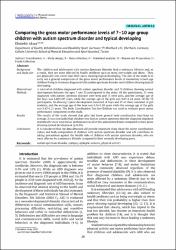| dc.contributor.author | Aksay, Ebubekir | |
| dc.date.accessioned | 2023-10-04T03:39:26Z | |
| dc.date.available | 2023-10-04T03:39:26Z | |
| dc.date.issued | 2022 | en_US |
| dc.identifier.issn | 2664-9837 | |
| dc.identifier.uri | https://hdl.handle.net/11363/5739 | |
| dc.description.abstract | Background
and Study Aim: The children and adolescents with Autism Spectrum Disorder lead a sedentary lifestyle and, as
a result, they are more affected by health problems such as being overweight and obese. They
are physically less active than their peers showing typical developing. The aim of the study is to
carry out a general comparison of the gross motor performance levels of elementary school-age
children living in Germany diagnosed with autism spectrum disorder and children showing typical
developing.
Material and
Methods: A total of 68 children diagnosed with autism spectrum disorder and 73 children showing normal
development between the ages 7 and 10 participated in the study. Of the participants, 55 were
diagnosed with autism spectrum disorder were boys and 13 were girls, and the average age of
the boys was 8.40±1.09 years, while the average age of the girls was 8.85±1.14 years. Of the 73
participants, 36 showing typical development consisted of boys and 37 of them consisted of girl
students, and the average age of the boys was 8.56±1.08 years while the average age of the girls
was 8.43±1.21 years. The Body Coordination Test for Children was used to evaluate gross motor
performance components in the study.
Results: The results of the study showed that girls had lower general body coordination than boys on
average. It was concluded that children who had an autism spectrum disorder diagnosis displayed
statistically lower total motor performance in all of the administered tests compared to their peers
showing normal development (p<0.05).
Conclusions: It is considered that the data obtained will provide important clues about the motor coordination
values and body composition of children with autism spectrum disorder and will contribute to
taking precautions against the health risks of children with autism spectrum disorder, who are
more affected by a sedentary lifestyle compared to their normally developing peers. | en_US |
| dc.language.iso | eng | en_US |
| dc.publisher | IERMAKOV S S, BOX 11135, KHARKOV-68 61068, UKRAINE | en_US |
| dc.relation.isversionof | 10.15561/26649837.2022.0104 | en_US |
| dc.rights | info:eu-repo/semantics/openAccess | en_US |
| dc.rights | Attribution-NonCommercial-NoDerivs 3.0 United States | * |
| dc.rights.uri | http://creativecommons.org/licenses/by-nc-nd/3.0/us/ | * |
| dc.subject | autism spectrum disorder | en_US |
| dc.subject | epilepsy | en_US |
| dc.subject | epileptic seizures | en_US |
| dc.subject | physical activity | en_US |
| dc.title | Comparing the gross motor performance levels of 7–10 age group children with autism spectrum disorder and typical developing | en_US |
| dc.type | article | en_US |
| dc.relation.ispartof | Pedagogy of Physical Culture and Sports | en_US |
| dc.department | Beden Eğitimi ve Spor Yüksekokulu | en_US |
| dc.authorid | https://orcid.org/0000-0002-5706-6698 | en_US |
| dc.identifier.volume | 26 | en_US |
| dc.identifier.issue | 1 | en_US |
| dc.identifier.startpage | 26 | en_US |
| dc.identifier.endpage | 37 | en_US |
| dc.relation.publicationcategory | Makale - Uluslararası Hakemli Dergi - Kurum Öğretim Elemanı | en_US |
| dc.contributor.institutionauthor | Aksay, Ebubekir | |



















